Sage for the bees
by Diane - July 18th, 2012.Filed under: Crocus.
Another brilliant herb for the garden.
As well as the traditional sage for cooking there are other sages that are more decorative and the bees love them! They smell lovely too!

Salvia x sylvestris ‘Rose Queen’ (sage) £7.99
Position: full sun or partial shade Soil: light, moderately fertile, humus-rich, moist but well- drained soil Rate of growth: average Flowering period: June and July Flower colour: bright rose-pink Other features: attractive to butterflies and bees; wrinkled, grey-green leaves Hardiness: fully hardy Slender spires of bright rose-pink flowers, which open from dark pink buds from early to midsummer, look lovely and attract butterflies and bees to the garden. ‘Rose Queen’ is perfect for filling gaps left by spring-flowering plants in the middle of a moist, well-drained herbaceous border. Garden care: To prolong flowering remove the flower spikes as soon they start to fade. Apply a generous 5-7cm (2-3in) mulch of well-rotted garden compost or manure around the base of the plant in spring.
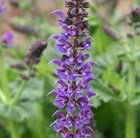
Salvia x sylvestris ‘Mainacht’ (sage (syn. Salvia May Night)) £5.99
Position: full sun or partial shade Soil: light, moderately fertile, humus-rich, moist but well- drained soil Rate of growth: average Flowering period: June and July Flower colour: indigo-blue Other features: attractive to butterflies and bees; wrinkled, grey-green leaves Hardiness: fully hardy A delightful, colourful plant with spikes of indigo-blue flowers in early to midsummer. This reliable perennial is ideal for the middle of a moist, well-drained herbaceous border. It flourishes in sun or dappled shade where the bright flowers help to liven up any plant scheme. Garden care: To prolong flowering remove the flower spikes as soon they start to fade. Apply a generous 5-7cm (2-3in) mulch of well-rotted garden compost or manure around the base of the plant in spring.

Salvia uliginosa ‘African Skies’ (bog sage) £4.99
Position: full sun Soil: moderately fertile, moist soil Rate of growth: average Flowering period: July to September Flower colour: sky blue Other features: aromatic foliage Hardiness: frost hardy (needs winter protection) Slender branching stems are clothed in aromatic green leaves. From midsummer, these tall stems are then topped with elegant racemes of sky blue flowers, which attract bees, butterflies and other beneficial insects into the garden. Forming quite large-sized clumps, it thrives in a sunny spot with reliably moist soils. Garden care: To prolong flowering remove the flower spikes as soon they start to fade. Apply a generous 5-7cm (2-3in) mulch of well-rotted garden compost or manure around the base of the plant in spring.
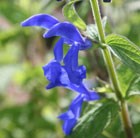
Salvia patens (sage) £7.99
Position: full light (with shade from hot sun) Soil: well-drained Rate of growth: average Flowering period: July to September Flower colour: blue Hardiness: frost hardy (needs winter protection) Superb vigorous variety of ornamental sage with slender spires of large blue flowers from midsummer to autumn. A perfect plant for a cool planting scheme or for adding to a mixed border where it will add vibrancy. Garden care: To prolong flowering remove the flower spikes as soon they start to fade. Apply a generous 5-7cm (2-3in) mulch of well-rotted garden compost or manure around the base of the plant in spring.

Salvia officinalis (common sage) £6.99
Position: full sun or partial shade Soil: light, fertile, moist, well-drained soil Rate of growth: average to fast Flowering period: May to July Flower colour: lilac-blue Other features: the leaves can be used fresh or dried to make stuffings, herb teas and herb butter Hardiness: fully hardy Spikes of lilac-blue flowers in early to mid-summer and grey-green aromatic leaves. Sage’s handsome foliage makes a fabulous and robust edge for a sunny herb garden or mini potager. Collected before the plant has flowered and freshly chopped, the aromatic leaves are valuable for flavouring stuffings, herbal teas and meat dishes. Garden care: To encourage a plentiful supply of young foliage gather the leaves regularly and prune lightly in July after flowering.

Salvia officinalis ‘Purpurascens’ (Purple Sage) £4.99
Position: full sun or partial shade Soil: light, fertile, moist, well-drained soil Rate of growth: average to fast Flowering period: May to July Flower colour: lilac-blue Other features: the leaves can be used fresh or dried to make stuffings, herb teas and herb butter Hardiness: fully hardy An attractive, upright perennial with aromatic, grey green foliage, which is initially flushed with a reddish-purple as it emerges. From early summer the branching stems are topped with spires of lilac-blue, two-lipped flowers, which are particularly loved by bees. A valuable addition to the herb garden, the leaves are high in vitamins A and C and can be used to make stuffings, as well as enhance the flavour of many meat and fish dishes. Garden care: To encourage a plentiful supply of young red- purple foliage gather the leaves regularly and prune lightly in July after flowering.
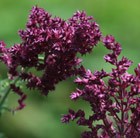
Salvia nemorosa ‘Schwellenburg’ (meadow sage) £15.99
Position: full sun Soil: light, moderately fertile, humus-rich, moist but well- drained soil Rate of growth: average Flowering period: July to September Flower colour: pinky-purple Other features: attractive to butterflies and bees Hardiness: fully hardy Dense and upright in habit, the grey-green foliage contrasts perfectly with the rose-tinted, purple flowers. This plant has a long flowering period providing it gets plenty of sun and you remove the spent flowers as they fade. It tends to flower a little later than most other salvias, so its a good one to choose of you are looking to prolong the summer colour. Garden care: To prolong flowering remove the flower spikes as soon they start to fade. Cut back all the stems after they have finished flowering and apply a generous 5-7cm (2-3in) mulch of well-rotted garden compost or manure around the base of the plant in spring.
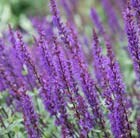
Salvia nemorosa ‘Caradonna’ (sage) £5.99
Position: full sun Soil: light, moderately fertile, humus-rich, moist but well- drained soil Rate of growth: average Flowering period: June to October Flower colour: violet-blue Other features: attractive to butterflies and bees Hardiness: fully hardy A superb cultivar with glowing purple stems loaded with violet-blue flowers from June to October. The grey-green, aromatic foliage also makes an attractive accent in the summer border. A compact variety that is perfect for adding a splash of colour at the front of a well- drained herbaceous border or gravel garden. It thrives in a sunny spot and will become drought tolerant once established. The blooms are a magnet for butterflies and bees. Garden care: To prolong flowering remove the flower spikes as soon they start to fade. Apply a generous 5-7cm (2-3in) mulch of well-rotted garden compost or manure around the base of the plant in spring.
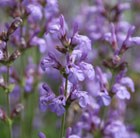
Salvia lavandulifolia (Spanish sage) £7.99
Position: full sun Soil: moderately fertile, humus-rich, well- drained soil Rate of growth: average Flowering period: July to September Hardiness: fully hardy Originating from rocky and stony places in the mountains of Spain, this sun loving, drought tolerant plant is quite a tough customer. Its leaves are edible and in Spain, it is the only sage used. It has smaller leaves and a stronger flavor and smell than our common sage. The flowers are glorious too and appear in mid to late summer. It needs a sunny spot, but looks great in a mixed, informal border, potted up with a selection of other herbs, or even gracing a dry stone wall. Garden care: To prolong flowering remove the flower spikes as soon they start to fade. Apply a generous 5-7cm (2-3in) mulch of well-rotted garden compost or manure around the base of the plant in spring.

Salvia guaranitica ‘Black and Blue’ (sage) £9.99
Position: full sun Soil: moderately fertile, moist but well-drained soil Rate of growth: average Flowering period: August to October Flower colour: dark purple-blue Other features: softly hairy foliage Hardiness: half hardy (will need protection during winter) The flower colour of this glorious perennial is quite simply breath-taking, and this coupled with the plants strong architectural presence, will ensure that heads will be turned towards the back of the border. From late summer to late autumn, 30cm long upright spikes carry sumptuously coloured purple-blue flowers, which are held at their bases by near-black calyces – hence the name ‘Black and Blue’. This is a vigorous plant, but it is not fully hardy, so it will need some protection in winter. Therefore, it is ideally suited to grow near a sheltered, south facing wall. Garden care: To prolong flowering remove the flower spikes as soon they start to fade. Apply a generous 5-7cm (2-3in) mulch of well-rotted garden compost or manure around the base of the plant in autumn to help keep the roots warm.

Salvia argentea (sage) £9.99
Position: full sun or partial shade Soil: light, moderately fertile, moist but well-drained Flowering period: July to August Other features: silver-wooly folaige Hardiness: fully hardy Primarily grown for its softly-hairy, silvery foliage, which forms impressive clumps, in its second year, it will also produce an upright branching flowerspike, bearing white to pink-flushed flowers. Magestic plants which are are mainly bi-ennial, or short-lived perennials, although they usually self-seed freely in good conditions. A classic for gravel or Mediterranean-style gardens. Garden care: Protect from excessive winter wet. To prolong flowering remove the flower spikes as soon they start to fade. Apply a generous 5-7cm (2-3in) mulch of well-rotted garden compost or manure around the base of the plant in spring.






